Four of the popular species of livebearers--guppies, mollies, platys and swordtails--compose a large percentage of the tropical fish hobbyist market today. This is due to a number of factors, including the fact that they are hardy, relatively peaceful, very colorful, and among the easiest fish to breed.
"Livebearer" describes any animal that bears its young live, instead of by laying eggs--in that way, even humans and most mammals are "livebearing" also. With cold-blooded animals such as fish, this is a rarer reproductive method used only by a small subset of fish. In addition to the four species described above, there are also rarer species (with regards to the tropical hobbyist field) that are livebearing. These include mosquitofish, which are native as far north as southern North America and are closely related to wild guppies,
and more exotic "weird" and unrelated fish like the halfbeak and the four-eyed fish,Anableps.
Below, I have just a few notes on the individual species, but their care and breeding is very similar between the species, so I have general livebearer comments at the bottom.
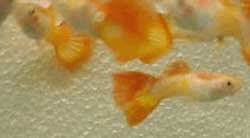
Perhaps the most well-known tropical fish, the guppy today continues to be very popular among both beginners and advanced breeders. Today, there are hundreds of beautiful varieties, from lyretails to fantails coming in a rainbow of colors and patterns, seemingly only limited by the imagination (they were all originally developed from wild guppy strains, which show a great deal of variation in color and tail shape, as you may notice from the relatively dull-looking "feeder guppies" you see at the pet store). Because of all the intense breeding,
however, most of the hardiness has been bred out of many strains of this species.
As a rule, the fancier the variety, the harder it is to raise it well. In fact, I would not recommend them for community tanks at all, as many seem more susceptible to disease lately. Their big tails seem like the perfect sites for infections to take hold. They are as a general rule, beautiful and peaceful little fish that can do best in smal, species-only tanks or ones with just a few other species, such as a livebearer community tank.
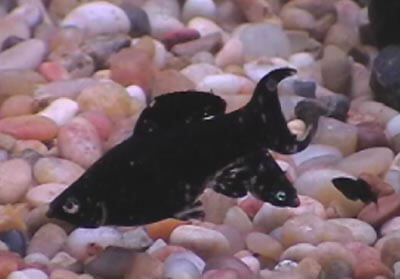
There are a number of different color, shape, and fin varieties that have been bred today; they include the black molly (shown above), dalmation molly (white with black speckles), the silver molly (shown in some photos below under breeding), and a squat-bodied form called the balloon molly. All these breeds originated from the wild saifin molly, P. latipinna, and all can also be bred to be longfinned. While it is true that most mollies prefer slightly alkaline water, and really are borderline brackish water fish which do best with a little sea salt, from my experience, they are also a highly adaptable and robust group. They are usually relatively peaceful fish, grazing on algae when they aren't filling up their greedy little bellies, but sometimes a large female will turn into a bully of smaller fish.
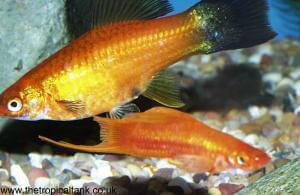
The swordtail is extremely closely-related to the platy, above, and in fact, they share the same genus name and will often hybridize. Care-wise, they really are not different at all, though some would say they have more sleek and torpedo-shaped bodies and thus have slightly more swimming room requirements. For the most part, the only major difference is just in appearence: male swordtails have a "sword" at the bottom of their caudal fin (tail), as seen above in the bottom fish.
Male livebearers are easily distinguished from females by the presence of a gonopodium, an anal fin modified into a point. This is illustrated below very clearly, in a male silver sailfin molly:
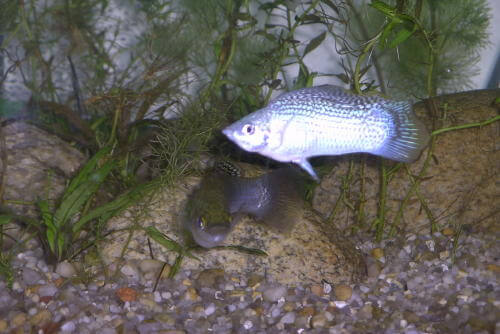
This is in contrast to the female anal fin, which is splayed out like a fan, like all her other fins. This female silver molly, shown below with some of her grown young, illustrates the difference:
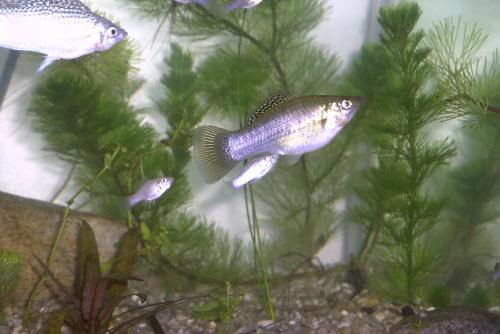
Livebearers are also known as the "rabbits of the fish world" and will breed easily, even in a beginner's tank. On occasion, you may notice some tiny movement in the gravel and find a pair of eyes (almost half the size of their body) staring back at you! Young fry should be siphoned out away from the hungry community tank occupants and raised separately on tiny foods such as baby brine shrimp, rotifers, mosquito midges, Drosophila larvae or Daphnia (livebearer fry are hardier and bigger when born, in general, than their egglayer counterparts, and will usually also take crumbled flake; sometimes they even survive in the community tank). The water should be crystal clear and changed frequently, as babies are more delicate and die of disease and pollution at the drop of a hat, sometimes with no visible symptoms (they are so tiny!). Make sure that the filter has a sieve cover that prevents the tiny fry from getting sucked in, or just use a sponge filter, which is great for fry tanks because the flow is indirect and weak). It takes a little over a month before young grow to a size (bigger than inch) where they can be readmitted into a community tank environment.
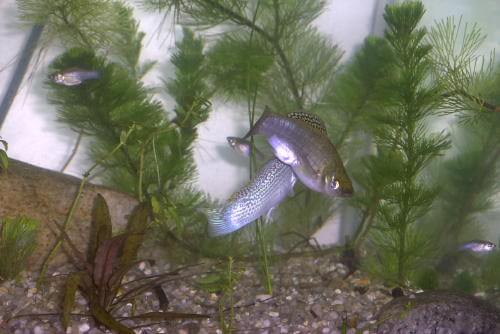
As one final note, please make sure you have enough room for all the babies if you attempt to breed them (or I should say, allow them to breed, since they will do so so easily). As with all pets, pet ownership is a responsibility; if you do not have the room for what may potentially end up being a large group (50-100!) of full-grown livebearers, then try and keep males and females separate. They can and will overpopulate their own tanks through their own breeding habits if given a chance, which can become a real problem once the young start to grow to full size. This will end up causing a total tank crash as they grow, and none of your fish can be maintained healthy in this sort of overpopulated environment. Another alternative is a natural form of culling (killing off young quickly and painlessly)--just buy fish that you know will eat the young right away, such as tetras and danios (make sure you have enough room for THOSE and that they are compatible with the adults before purchasing!). Also, many times parents will cannabilize their own young shortly after birth, which is fine and preferable to letting them suffer in an overpopulated tank, but sometimes some will get away. If you truly are interested in raising them, then just make sure you have the means to either give them more room in a separate tank later, or find them all good homes where they are wanted as they grow larger.